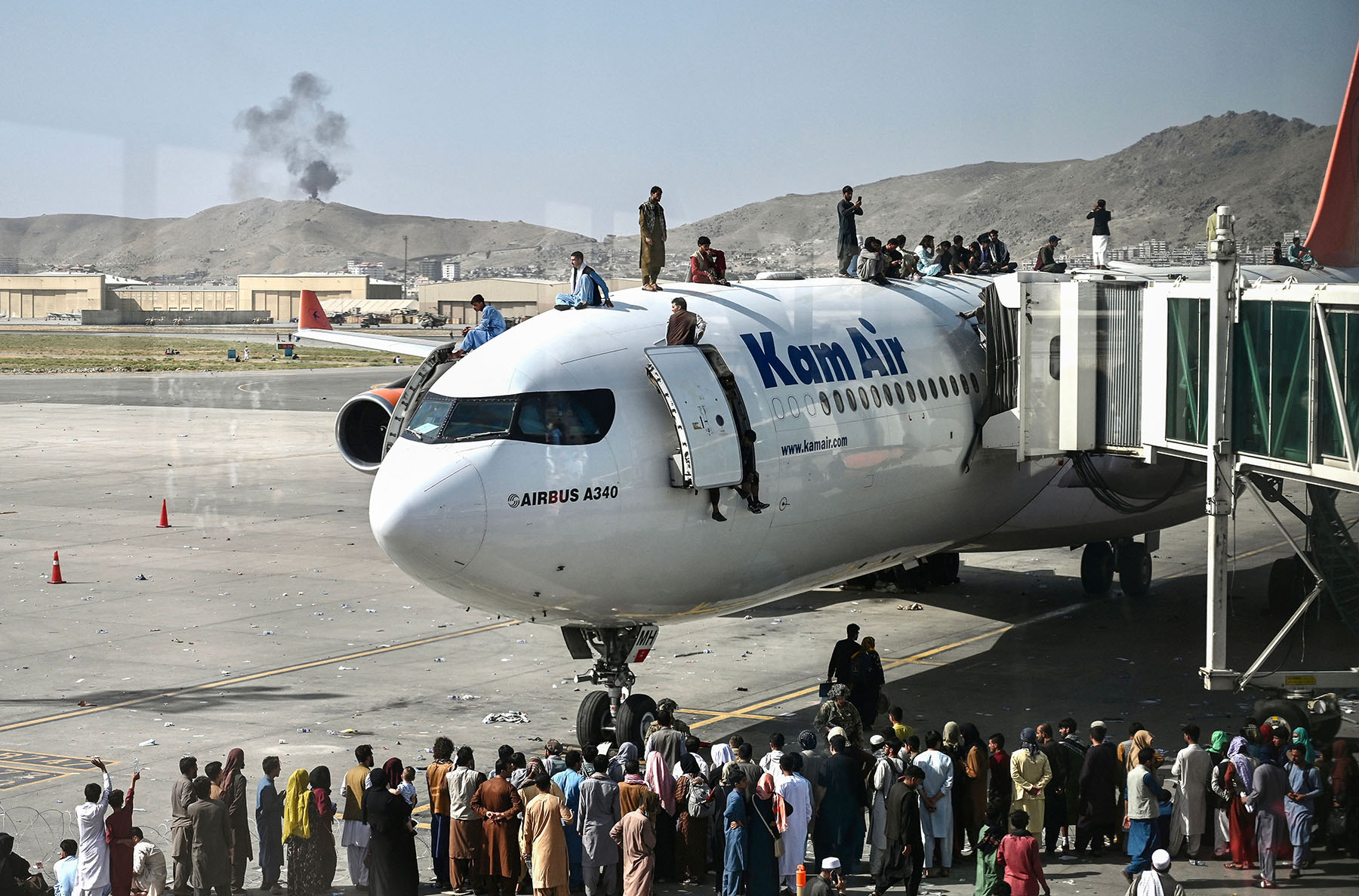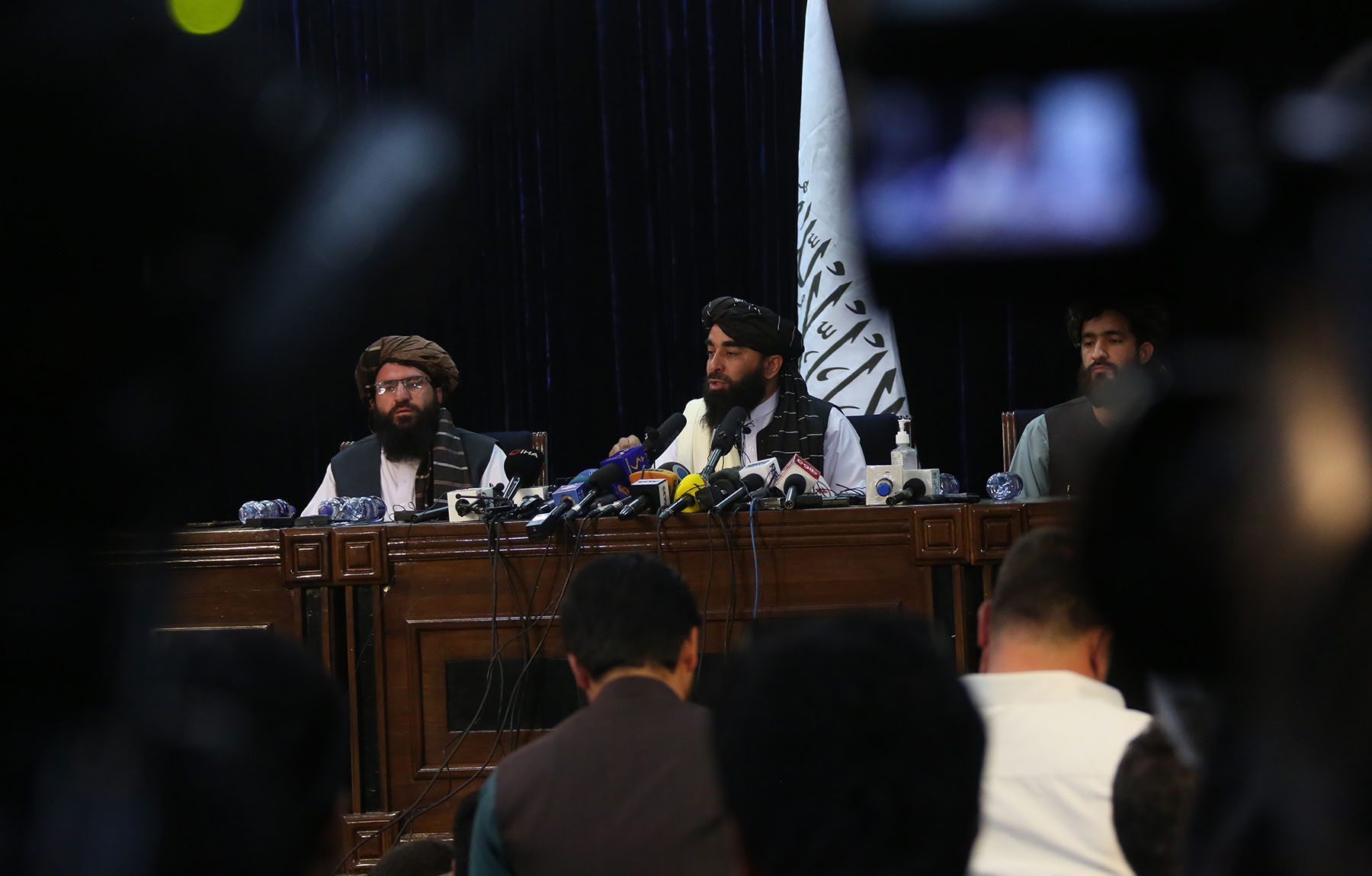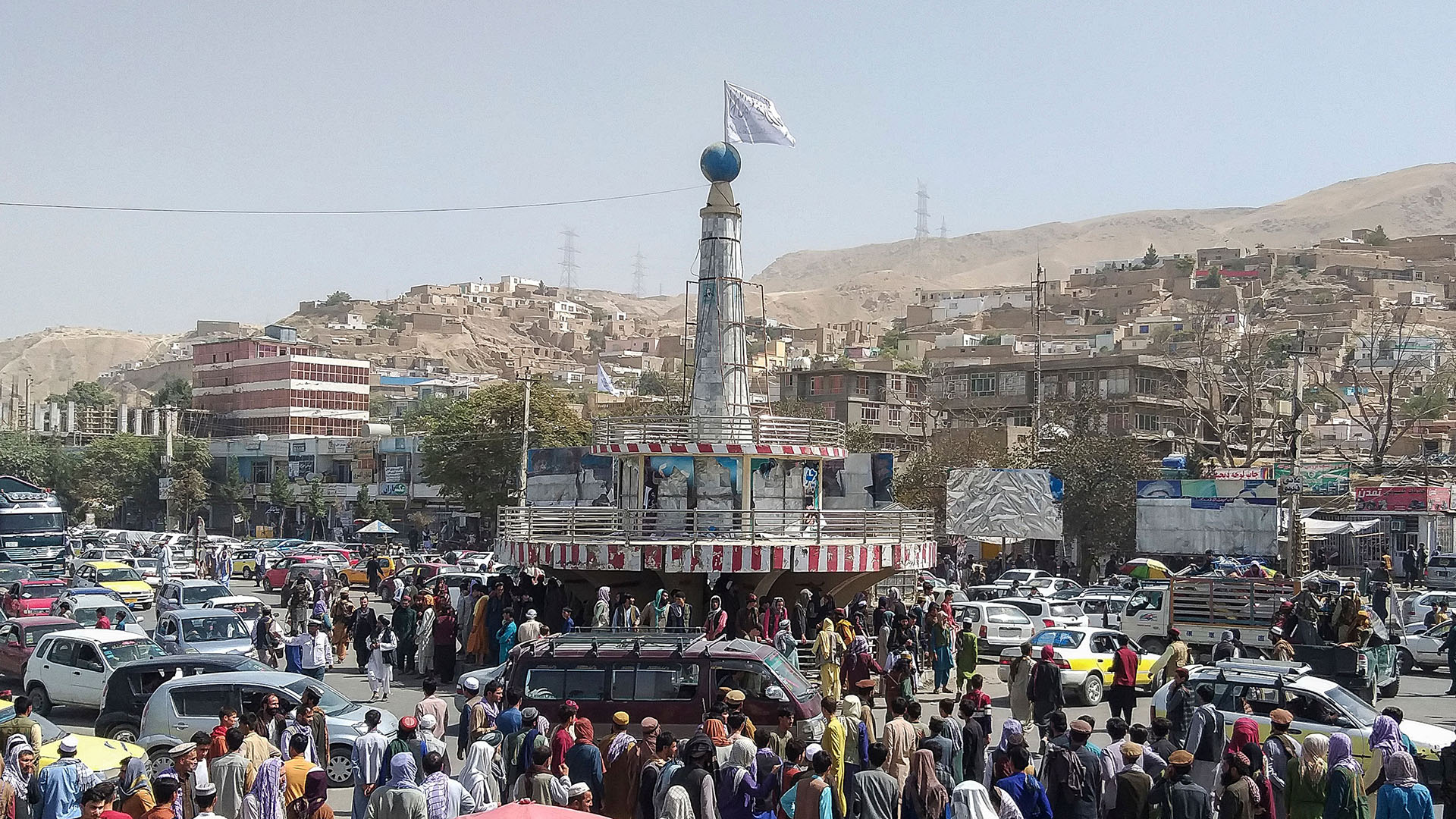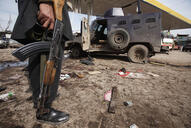After the withdrawal of U.S. troops from Afghanistan in August 2021, the Taliban rapidly regained control of the country and the government in Kabul. Despite initial promises to respect human rights, the Taliban steadily reimposed its strict interpretation of sharia-based law on the country, including public executions, amputations, and flogging. Since the takeover, those living under Taliban rule have witnessed the regression and reversion of any gains in liberal and democratic rights and freedoms over the last twenty years. The Taliban has imposed harsh restrictions on women’s rights to education, employment, free speech and movement, and dress. Women who have protested have been harassed, threatened, detained, arrested, tortured, and forcibly disappeared. Meanwhile, Afghanistan continues to face one of the world’s worst humanitarian crises, exacerbated by devastating economic shocks and the worsening effects of climate change. These factors have caused widespread displacement, poverty, and food insecurity; an estimated 23.7 million Afghans required humanitarian aid as of February 2024. The Islamic State of Khorasan Province (ISKP), the Afghan affiliate of the Islamic State, also continues to target civilians through bombings and other attacks, contributing to ongoing instability and conflict.
The Taliban, a Sunni Islamic fundamentalist and predominantly Pashtun movement, controlled most of Afghanistan from 1996 to 2001. In October 2001, U.S. and allied forces invaded the country and quickly ousted the Taliban regime following its refusal to hand over terrorist leader Osama bin Laden in the wake of al-Qaeda’s 9/11 attacks. Following the U.S.-led invasion, Taliban leadership relocated to southern Afghanistan and across the border to Pakistan, from where they waged an insurgency against the Western-backed government in Kabul, Afghan national security forces, and international coalition troops.
When the U.S.-led coalition formally ended its combat mission in 2014, the Afghan National Defense and Security Forces (ANDSF) was put in charge of Afghanistan’s security; however, the forces faced significant challenges in holding territory and defending population centers. The Taliban continued to attack rural districts and carry out suicide attacks in major cities, with the ANDSF suffering heavy casualties. The war largely remained a stalemate for nearly six years, despite a small U.S. troop increase in 2017, continuing combat missions, and a shift in U.S. military strategy to target Taliban revenue sources, which involved air strikes against drug labs and opium production sites. The Taliban briefly seized the capital of Farah Province in May 2018, and, in August 2018, it captured the capital of Ghazni Province, holding the city for nearly a week before U.S. and Afghan troops regained control.
In February 2020, after more than a year of direct negotiations, the U.S. government and the Taliban signed a peace deal, the so-called Doha Agreement [PDF], that set a timeline for the withdrawal of U.S. troops from Afghanistan. Under the agreement [PDF], the United States pledged to draw down U.S. troops to approximately 8,500 within 135 days and complete a full withdrawal within fourteen months. In return, the Taliban pledged to prevent territory under its control from being used by terrorist groups and to enter negotiations with the Afghan government. However, no official ceasefire was put in place. After a brief reduction in violence, the Taliban quickly resumed attacks on Afghan security forces and civilians. Direct talks between the Afghan government and the Taliban began months after the agreed-upon start of March 2020; however, the negotiations faced multiple delays and ultimately made little progress. Violence across Afghanistan continued in 2020 and 2021 as the United States increased air strikes and raids targeting the Taliban. The Taliban, in turn, attacked Afghan government and ANDSF targets and made significant territorial gains.
Civilian casualties across Afghanistan have remained high over the past several years. The United Nations documented a then–record high of 10,993 civilian casualties in 2018. Although 2019 saw a slight decline, civilian deaths and injuries exceeded ten thousand for the sixth year in a row, bringing the total UN-documented civilian casualties from 2009 to 2020 to more than one hundred thousand. Despite another slight decline that year, the first half of 2021 saw a record-high number of civilian casualties as the Taliban ramped up their military offensive amid the withdrawal of international troops. In addition to the Taliban’s offensive, Afghanistan faces a threat from the Islamic State in Khorasan (ISIS-K), which has also expanded its presence to several eastern provinces, increased its activity in Kabul, and targeted civilians with suicide attacks.
In April 2021, U.S. President Joe Biden announced that U.S. military forces would leave Afghanistan by September 2021. The Taliban, which had continued to capture and contest territory across the country despite ongoing peace talks with the Afghan government, ramped up attacks on ANDSF bases and outposts and began to rapidly seize more territory. In May 2021, the U.S. military accelerated the pace of its troop withdrawal. By the end of July 2021, the United States had completed nearly 95 percent of its withdrawal, leaving just 650 troops to protect the U.S. embassy in Kabul.
In the summer of 2021, the Taliban continued its offensive, threatening government-controlled urban areas and seizing several border crossings. In early August, the Taliban began direct assaults on multiple urban areas, including Kandahar in the south and Herat in the west. On August 6, 2021, the Taliban captured the capital of southern Nimruz Province, the first provincial capital to fall. After that, provincial capitals began to fall in rapid succession. Within days, the Taliban captured more than ten other capitals, including Mazar-i-Sharif in the north and Jalalabad in the east, leaving Kabul the only major urban area under government control. On August 15, 2021, over two weeks before the official U.S. withdrawal deadline, Taliban fighters entered the capital. Afghan President Ashraf Ghani subsequently fled the country and the Afghan government collapsed. Later that same day, the Taliban announced they had entered the presidential palace, taken control of Kabul, and were establishing checkpoints to maintain security.
The speed of the Taliban’s territorial gains and the collapse of both the ANDSF and Afghan government surprised U.S. officials and allies—as well as, reportedly, the Taliban itself—despite earlier intelligence assessments of the situation on the ground. Following the Taliban’s take-over on August 15, 2021, the Biden administration authorized the deployment of an additional five thousand troops to assist with the evacuation of U.S. and allied personnel, as well as thousands of Afghans who worked with the United States and were attempting to flee. On August 26, 2021, two suicide bombings outside the Kabul airport killed at least 169 Afghans and thirteen U.S. troops. ISIS-K claimed responsibility for the attacks. August 26, 2021, was the deadliest day for U.S. troops in Afghanistan since 2011. On August 31, 2021, the Pentagon announced the completion of the U.S. troop withdrawal, with remaining U.S. personnel and citizens having to rely on diplomatic channels to evacuate.
On September 17, 2021, following an investigation by the New York Times and the Washington Post, the Pentagon reversed an initial statement it made regarding the last U.S. drone strike in Afghanistan prior to the official U.S. withdrawal from the country. Although the head of U.S. Central Command, Marine General Frank McKenzie, admitted that the “strike was a tragic mistake” resulting in ten civilian deaths, the Pentagon decided in December 2021 that no military personnel would be punished for the attack.
Following the U.S. withdrawal from Afghanistan, more than 120,000 Afghans were airlifted and relocated around the world, with about 76,000 arriving in the United States as of August 2022. Those remaining in the country under Taliban rule have watched the regression and reversion of any gains in liberal and democratic rights and freedoms over the last twenty years. Girls are once again barred from secondary schools. Women are required to have a male-relative companion when traveling significant distances and to cover their faces in public. Music has been banned and flogging, amputations, and mass executions have been reintroduced. According to a New York Times investigation, the Taliban has killed or forcibly disappeared nearly five hundred former government officials and members of the Afghan security forces in just its first six months in power. Afghans also remain at a heightened risk of terrorist attacks, such as the August 2022 bombing of a mosque and the September 2022 bombing of the Russian Embassy, both in Kabul, allegedly perpetrated by the Islamic State.
Afghans are also suffering from cascading and compounding humanitarian crises and face the largest humanitarian crisis in the world, according to the United Nations. In January 2022, the United Nations launched the largest single-country aid appeal in its history to finance humanitarian assistance for Afghanistan. By March 2022, 95 percent of Afghan households did not have enough to eat, and more than 3.5 million children were in need of nutrition treatment support. By August 2022, six million people were “on the brink of famine.” Climate change, which has increased the frequency and intensity of natural disasters and extreme weather, has elevated the population’s exposure to food shortages, with searing heatwaves and flash flooding destroying crops and arable land. Afghans have also seen food prices soar as a result of the Russia-Ukraine war.
The humanitarian situation in Afghanistan has also been exacerbated by an economy on the verge of collapse and international isolation. Sanctions and the termination of significant development aid have crippled the Afghan economy. The revocation of the country’s central bank’s credentials halted all basic banking transactions and drastically restricted critical cash flow relied on by Afghan families for daily market activities. Furthermore, skyrocketing inflation has meant an over 50 percent increase [PDF] in the price of goods from July 2021 to June 2022. Obtaining external assistance to contend with domestic economic havoc is complicated by the West’s reticence to work with the Taliban government over concerns that doing so would bolster the regime’s legitimacy. Despite the humanitarian exceptions issued by the United Nations, the United States, and other countries that have imposed sanctions on Afghanistan since the Taliban usurped power, the country remains starved of assistance. Additionally, no foreign government has to date formally recognized the Taliban and, in response to a June 2023 Taliban request for UN recognition, the UN envoy to Afghanistan said that it is “nearly impossible” as long as the Taliban maintains its restrictive laws on women and girls.
In May 2022, the Special Inspector General for Afghanistan Reconstruction released an interim assessment [PDF] of the United States’ involvement in and withdrawal from Afghanistan. The report cited the decision “to withdraw military forces and contractors from Afghanistan” under the Doha Agreement (signed during the Donald J. Trump administration and confirmed by President Biden in April 2021) as the “single most important near-term factor in the ANDSF’s collapse.” Many Afghans viewed the agreement as “an act of bad faith” that signaled the U.S. government’s intention to hand over the country to the Taliban while rushing to evacuate. The report also detailed nine factors explaining why the ANDSF was so poorly prepared to maintain security after the U.S. withdrawal despite two decades of support “and nearly $90 billion in U.S. security assistance,” including the creation of U.S. “long-term dependencies” and “Afghan corruption.” Additionally, the Biden administration, which faced heavy criticism over the botched exit, released a report claiming the Trump administration bears most of the responsibility, having waited too long to begin withdrawal preparations, “severely constraining” Biden’s options.
On August 1, 2022, President Biden announced the killing of Ayman al-Zawahiri, one of the perpetrators of the 9/11 attacks and Osama bin Laden’s successor as the leader of al-Qaida. A day prior, U.S. forces fired two Hellfire missiles on a house in downtown Kabul where U.S. intelligence indicated Zawahiri was residing as a guest of the Taliban. The Biden administration condemned the Taliban’s harboring of Zawahiri on Afghan soil as a violation of the 2020 Doha Agreement.
In November 2022, the Taliban announced a slate of new extreme laws, including banning women from parks and gyms and reintroducing public flogging and executions. In December 2022, the Taliban further rolled back women’s educational rights, barring them from university grounds and tutoring centers after having allowed them to take entrance exams earlier that year. In addition to drawing harsh international criticism, the Taliban’s strict laws prompted even Qatar and China, some of its closest partners, to lobby for an easing of restrictions in May 2023. However, international condemnation has failed to change Taliban behavior; the Taliban maintains its position on women and girls, which the UN characterized as “gender apartheid,” continues to conduct hundreds of public floggings, and carried out its second public execution in June 2023.
The Taliban has also made it more difficult for aid agencies to operate in Afghanistan by harassing aid workers and banning women from working for the UN. Along with a loss of donors due to anger over Taliban policies, these conditions have forced the UN to reduce its funding request for Afghanistan by one billion dollars. The World Food Programme said the overall drop in funding could deprive an additional nine million Afghans of food aid. The Taliban has also cracked down on opium production, cutting production by 80 percent, which has deprived many Afghan communities of revenue needed to purchase food. Meanwhile, water shortages have led to conflict with Iran, including gunfire at the border, over access to water in the Helmand River.
A 2023 Pentagon assessment found that the Islamic State is again using Afghanistan as a base to plan and coordinate attacks across the globe. ISIS-K has also stepped up attacks in Afghanistan, such as the killing of a deputy governor and the bombing of a mosque, as the UN claims al-Qaeda and ISIS-K are gathering strength. The Taliban has fought back and claims to be eliminating ISIS-K, but attacks continue. However, in April 2023, Taliban forces did manage to kill one of the group’s senior leaders who orchestrated the 2021 suicide bombing at Kabul International Airport. In May, the Taliban agreed to work with Pakistan on improving security along their shared border, which militants freely traverse.










